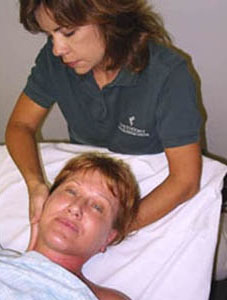JACKSON, Miss.—During her fight to survive a virulent form of breast cancer, Toni Gary endured high-dose chemotherapy, rounds of radiation and a double mastectomy.
It saved her life, but the price was unrelenting back pain.
“It felt like someone was twisting a big two-by-four under my shoulder blade,” said Gary, a psychology instructor at Mississippi Delta Community College in Moorhead. “It was so bad last June that I was almost suicidal.”
After narcotics, hypnosis and Botox injections didn’t ease her suffering, Gary thought her only option was an implanted pump that delivers morphine directly to the spine.
Instead, she found relief from a gentle therapy known as myofascial release (MFR). “It’s so good that I drive two hours each way twice a week for treatments,” she said.
Gary’s destination is Methodist Rehabilitation Center’s outpatient clinic in Flowood, where physical therapist Teresa Swyers and physical therapist assistant Meagan Belham practice the healing craft. The two learned MFR techniques from physical therapist John Barnes, a renowned expert who leads national seminars on the increasingly popular treatment.
Swyers describes MFR as a whole-body, hands-on approach that focuses on fascia, a network of stretchy tissue that encases everything in the body like a protective stocking.
“It’s like a spider web and a strain on any one area affects the body’s total alignment,” Swyers explained. “Myofascial release uses gentle sustained pressure to activate the release of connective tissue to restore normal alignment and decrease the strait jacket of pain.”
Along with MFR, therapists work on strategies to help patients maintain a healthy posture -- such as flexibility and strengthening exercises. But it’s MFR’s focus on connective tissue that truly sets it apart from simple massage techniques, Belham said.
“If a therapist is not willing to look at the whole body and focus on postural alignment, they are just doing soft tissue massage,” she said.
The therapists say it’s not difficult to spot someone in need of MFR. Many show signs of pain and misalignments, and Gary was no exception. Hardened connective tissue and extensive scarring from radiation burns had left her painfully contorted.
“Before she came in here, her fascia was so restrictive that she reached up and broke a rib,” Belham said. “It was that adhered to the bone.”
The aim of MFR is to loosen such adhesions, and it’s literally a hands-on task. “You go down to where you find resistance and you hold that until it starts to move,” Belham said. “You are going with the tissue, not against it. It almost seems to liquefy in your hands.”
“It seems like you should be able to hear it because you can feel it ripping away,” Gary said. “It’s amazing how much difference it makes. I think these people are miracle workers.”
Swyers and Belham say they’re glad they took advantage of continuing education courses in MFR because they’ve seen how the therapy dramatically improves the lives of many patients.
“After my first MFR course, I came back and had a bull-riding patient who had 18 broken bones and we got him down to one pain point,” said Belham. “I said: This stuff works!”
And the best part is, it’s non-narcotic, said Gary. “I got so tired of medicine and its side effects. Before this I was on high doses of morphine and I was just drugged out all the time. But after the first time I had myofascial release, the pain went away. I have so much more range of movement now that it’s amazing. Everything I do feels different.”
For information on myofascial release therapy at Methodist Rehabilitation Center, call Susan Geiger at 601-936-8888.


